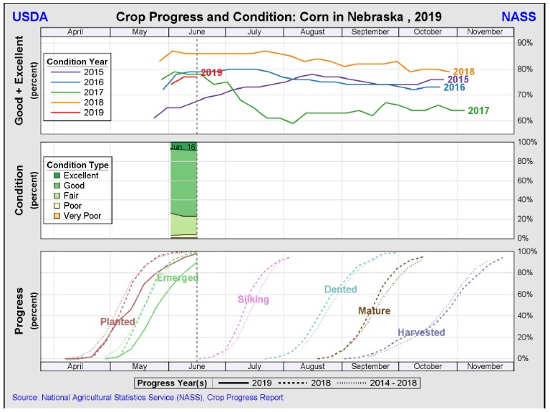BY Julie Peterson
How Will Slow Crop Progress Affect Western Bean Cutworm in 2019?
The timing of western bean cutworm (WBC) moth flights in relation to corn growth stage has an important impact on the survival of young larvae, and subsequently the amount of damage they can do to developing corn ears. Moths prefer to lay their eggs on late whorl to early tassel stage corn plants so that the young larvae will have fresh tassel tissue to feed upon. Survival of newly hatched WBC is the highest if they are able to feed on freshly emerged tassel prior to moving down into the developing ears. Survival is lowest if corn plants are still in the vegetative stage and there is no reproductive tissue available when the larvae hatch. Therefore, with late planting, slow emergence, and cooler summer temperatures affecting crop progress (Figure 1), you may hope that one positive side effect would be less damage from WBC in 2019. Unfortunately, that may not be the case.

Figure 1. Crop progress and conditions for corn from the USDA National Agricultural Statistics Service indicating predicted timing for corn growth stages (2019).
The same cooler temperatures that have affected crop progress can also lead to slower development of WBC. Insect development is dependent on variable weather conditions such as air and soil temperature. Using a degree-day model developed by UNL Entomologists Tom Hunt and Robert Wright, along with University of Minnesota researchers, we can predict when WBC moths will emerge to begin mating and laying eggs in corn and dry bean fields. Additional information on how this model uses temperatures to calculate degree-day accumulations and WBC development can be found in this 2018
CropWatch article.
Predicted Dates for 2019 Western Bean Cutworm Flights in Nebraska and Surrounding States
Our predictions for 2019 locations across Nebraska, Colorado, and Wyoming (Table 1) indicate that moth flight will be delayed compared to previous years. For example, North Platte shows that 25% moth flight will be on approximately July 23, 2019, whereas this level was reached on July 18 in 2018 and July 14 in 2017 and 2016. However, WBC should not be ignored over the next month: degree-day models can help predict when scouting should occur but should also be used in combination with other monitoring methods. Setting up pheromone traps or monitoring UNL’s
black light trap reports from North Platte, Clay Center, Concord, and Mead are additional resources. More information on these resources can be found in the bulleted list at the end of this article.